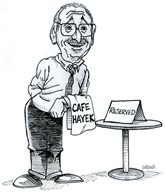This letter in today’s Wall Street Journal, by Melissa Newsham of Hawaii’s Grassroot Institute, is superb:
As reported in “U.S. Lags Far Behind Rivals Like China in Building Oceangoing Containerships” (Business News, March 3), America’s shipbuilding industry is minuscule compared with the rest of the world. But relying on protectionist policies as a solution is a mistake. We’ve already tried that with no success. Take the Jones Act of 1920, which requires goods transported between U.S. ports to be carried on domestically built vessels, among other requirements. Advocates claim the law is essential for protecting the maritime industry, but as the article documents, the industry has declined under the act’s watch, largely because U.S. shipyards enjoy a captive domestic market with no real competition. There are dedicated lobby groups whose sole purpose is to block even the most narrowly tailored exceptions to the law.
Meanwhile, as Matson builds three overpriced vessels in the Philly Shipyard, residents of my home state of Hawaii can expect to foot the bill through higher freight costs. The inflated cost of U.S.-built ships, which has risen faster than international counterparts, acts as a barrier to entry for potential competitors. Protectionist policies such as the Jones Act are more effective as de facto taxes than as a legitimate strategy for strengthening American shipbuilding.
Any hope of robust economic growth resulting from unleashing energy abundance, deregulating the private sector economy, or pro-growth tax policy may now be doused by the economic fallout of a pointless trade war.
It started as a murmur—a slight downward revision, nothing alarming. But within five days, the Federal Reserve Bank of Atlanta’s GDPNow forecast for the first quarter of 2025 went from mild optimism (2.3 percent growth) to outright recessionary territory (-1.5 percent). By March 3, the number had plunged to -2.8 percent, the kind of contraction that doesn’t just signal weakness but outright economic distress. Eight months of stock market gains were wiped out in less than four weeks.
Yet there is deafening silence from Washington. The Trump administration remains deeply committed to its protectionist crusade, under the misguided belief that tariffs and trade barriers come at no cost to Americans. But reality is setting in, and the numbers don’t lie. The ongoing trade war, with its uncertainty and economic distortions, is now visibly hammering investment, exports, and consumption—three pillars of growth.
…..
Global supply chains are rattled, businesses are reluctant to invest in capital, and consumers are cutting back on purchases. Tariffs—pitched as a way to bring jobs back—have instead choked growth. The administration’s bet that protectionism would insulate the economy from foreign competition is proving to be precisely the opposite: a self-inflicted wound.
The very politicians who decried economic stagnation in previous decades are now actively promoting it through top-down economic planning. This is industrial policy in practice—where Washington’s heavy hand tries to override the natural forces of markets.
We can’t say that we weren’t forewarned about this possibility. My colleague Veronique de Rugy wrote back in September that we shouldn’t expect a return to the Trump economy. As she observed, “several of his policy ideas are destructive.”
Michael Strain wonders “why Trump is undermining the U.S. economy.” A slice:
In recent weeks, Trump has reversed that good start. I fully endorse the goals of Elon Musk’s Department of Government Efficiency (DOGE) to reduce the scope of government activity and eliminate wasteful spending. But DOGE’s chaos has spooked consumers and investors. Worse, Trump’s on-again, off-again tariff increases and open hostility toward crucial trading partners (Canada, Mexico, and the European Union) have soured business and consumer sentiment, increased inflation expectations, chilled investment, and sent stocks plunging. On March 13, the S&P 500 sank into a correction, falling 10% from its record high three weeks previously.
Why is Trump doing this? I’ll offer three explanations. First, we are witnessing rank incompetence. As has been widely reported, DOGE has charged into federal agencies and fired workers, only to attempt to rehire them days later when it realized how important they were. It is repeatedly posting data with significant errors about its “spending cuts.” Clearly, there is no plan here. DOGE simply has no idea what it is doing, and all its frenetic activity has amounted to nothing but confusion. There have been no material spending cuts: Federal spending in February was higher than in any previous month. If anything, DOGE’s ineptitude is likely to set back the cause of reducing the size and scope of government.
Trump’s execution of trade policy has been equally incompetent. Many Trumpologists are trying to discern a strategy, as if the president were “playing five-dimensional chess.” He isn’t. There was no master plan, for example, behind his decision to enact a large tariff increase on Canada on March 4, then exempt automobile manufacturing on March 5, and then exempt goods in compliance with the United States-Mexico-Canada Agreement (USMCA) on March 6.
To hear others in the Administration talk, however, such a refusal may be coming. “They’re not gonna stop us,” Tom Homan, Mr. Trump’s immigration czar, told Fox News on Monday. “We’re not stopping. I don’t care what the judges think, I don’t care what the left thinks, we’re coming.”
Elon Musk threatened Judge Boasberg with impeachment, and the MAGA-sphere chanted that Mr. Trump should ignore the courts. Are we already arriving at a constitutional impasse when the Administration thinks it can ignore court orders?
Jason Furman offers sound insights about AI and AI regulation. (HT Arnold Kling) A slice:
Avoid setting up regulations that become a moat protecting incumbents. History shows that well-intentioned rules can entrench existing powers, from medieval guilds to hospital certificate-of-need laws (Mitchell 2021). It is possible that regulations in the AI space could follow the same pattern. Centralized licensing bodies could easily become gatekeepers stifling competition. A super-regulator could be captured by big companies. When tech giants enthusiastically promote regulation, it should raise red flags. A regulatory framework that aims to nurture a competitive AI landscape instead of solidifying the dominance of a few early movers should avoid these types of policies.
In this video, Kevin Corinth offers insights about the “poverty line.”
Jeffrey Miron and Jacob Winter are correct: “land-use regulations make housing less affordable.”
J.D. Tuccille reports that “pandemic lockdowns made the world ruder.”



